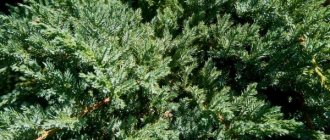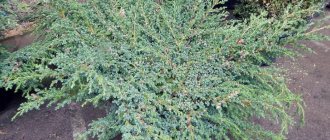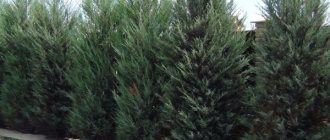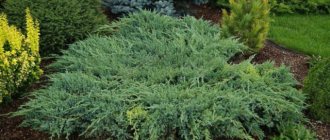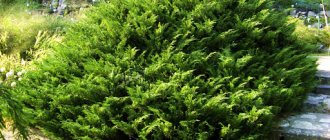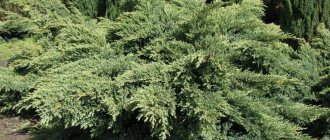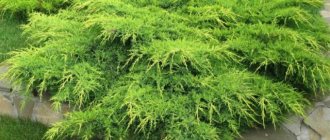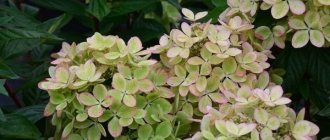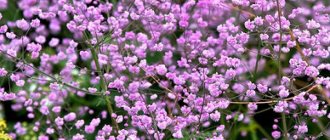Description of horizontal juniper Andorra Compact
Andorra Compact is a variety of prostrate (horizontal) juniper. It is an evergreen creeping shrub with the following characteristics:
- the crown is neat and dense, cushion-shaped or slightly funnel-shaped, nest-shaped in young animals;
- the root system is of a superficial type, develops poorly, grows widely;
- the needles are soft and small, narrow, 5 mm long, bluish or light green, with a purple tint in winter;
- formation of a dense and even cover;
- the bark is smooth and brown, may crack in mature plants;
- branches from the middle rise obliquely upward;
- the needles are scaly, sometimes needle-shaped, located on growth shoots in sparse whorls;
- cone berries (juniper berries) are fleshy, spherical in shape, color first green, then bluish-blue;
- the fruits are inedible.
Comment! Andorra Compact needs to immediately choose a permanent location. The variety does not like transplantation.
Andorra Compact can live up to two centuries.
A similar variety to Andorra Compact juniper is Variegata. It is distinguished by its green needles, which turn a deep lilac-purple in winter.
Winter hardiness zone of juniper Andorra Compact
Andorra Compact has high winter hardiness, zone 4. The variety can withstand frosts down to -29-34 °C. The shrub can be grown in Moscow and the Moscow region, Kazan, Volgograd, and Uralsk.
Size and growth rate
The juniper Andorra Compacta reaches 0.4-0.5 m in height and 2 m in diameter. The perennial grows slowly. During the first 10 years, the crown reaches a height of 0.3-0.4 m and a diameter of 1 m.
Over the course of a year, Andorra Compact grows vertically by 2-3 cm and becomes wider by 10-15 cm.
The growth of Andorra Compact depends on several points:
- the right place for planting - lighting, soil composition, its fertility;
- damage by diseases and pests, timely treatment and prevention;
- regularity of sanitary pruning.
The difference between the Variegata variety and the horizontal juniper Andorra Compact is the smaller diameter of the crown, which is also cushion-shaped. Its bushes reach 0.5 m, grow vertically up to 15 cm annually, and up to 30 cm in width.
Botanical description
According to the description, Andorra Compact juniper is an evergreen ornamental shrub, whose compact crown has a rosette or cushion shape. The needles of the plant are thick and small, the color is green or violet (purple) in the cold season. The diameter of the bush can reach 2 m with a fairly small height - about 0.3–0.4 m .
The shoots of the bush are distinguished by a greenish-brown tint, density and elevation. The bark of the branches is brown in color, smooth when young and prone to some cracking over time. The root system is well developed, but is located on the surface. Juniper produces spherical, green fruits, which later acquire a blue tint and a bluish coating, which gives the plant a special decorative appearance.
Important! Thanks to its strong rhizome, juniper is often planted on slopes to strengthen them.
Juniper Andorra Compacta in landscape design
The photo of the horizontal juniper Andorra Compact shows that it is effective both individually and in group plantings. It is good to plant in rock gardens and mixborders, and used for wide borders.
Several Andorra Compact bushes under the window will provide a pleasant view and clean air
In group plantings, low juniper is placed in the foreground. The background can be trees and bushes.
Andorra Compact can be combined with other conifers and flowers
Andorra feels great among the stones
Growing Andorra Compact in pots and flowerpots gives more space for design
Juniper can be grown in garden plots, parks and alleys. The plant is not afraid of city air, saturated with dust and gases.
Neighbors of Andorra Compact can be roses, heather, and ground cover pine. Dense planting of juniper strengthens the slopes well.
Planting and caring for juniper Andorra Compacta
Planting Andorra Compact outside is recommended in the spring, so that by the cold weather it has time to take root and adapt to new conditions. It is better to plan work for the beginning of May or the end of April. If you grow the plant as a container crop, then planting is possible until November.
Comment! If planted late, Andorra Compact may initially lag behind in growth and development.
Juniper Andorra Compact is quite unpretentious, but requires certain conditions:
- well-lit area, slight shading is acceptable;
- It is advisable that at noon the juniper is protected from direct sunlight;
- the soil is fresh and sandy or loamy;
- good drainage;
- soil reaction is slightly acidic or neutral.
Comment! Due to constant shading, Andorra Compact becomes loose and loses its decorative effect. The area should be illuminated for most of the day.
For planting, well-developed seedlings without signs of disease are needed. Age allowed is 1-2 years, the root system is branched. Material needs to be prepared:
- On the eve of planting, cut the roots by 3-5 cm and place them in a growth stimulator.
- Remove broken shoots, shorten the top with side branches by half.
Andorra Compact does not tolerate stagnant moisture. Good drainage must be ensured before planting. Broken red bricks or stones with coarse sand are suitable for this. A layer of 15-20 cm is needed.
If the soil is too heavy and dense, then peat and sand should be added in advance. Landing algorithm:
- Prepare the pit. Depth for adult plants is up to 0.7 m.
- Organize drainage.
- Fill the hole with a soil mixture - peat, turf soil and sand 2:1:1.
- Add mineral fertilizers. Choose a composition for conifers.
- Place the seedling with a clod of earth vertically into the hole.
- Fill the hole with earth and moisten it generously with warm water. Do not bury the root collar.
- Water by sprinkling method.
- Mulch the tree trunk circle. A layer of up to 10 cm is sufficient.
When planting Andorra Compact, there is no need to compact the soil; it should gradually settle on its own.
Plants should be planted at a distance of 0.5-2 m, focusing on their size. The optimal interval is 1 m. To decorate the borders, a trench is prepared, and seedlings are placed in it in increments of 0.4-0.6 m.
Advice! It is effective to add coniferous litter and soil from a spruce or pine forest into the planting hole. This promotes plant survival
How and when to plant
Andorra juniper is propagated using cuttings and seeds. But most often gardeners use cuttings. The fact is that when seeds are planted, seedlings lose all varietal characteristics. The growth of the bush occurs slowly, it is advisable to plant it in a sunny or slightly shaded area. But it is not advisable to replant it, since this is real stress for the plant. So after rooting the cutting, you must immediately decide on the place where the bush will grow for a long time. But the information from this article will help you understand what the Cossack creeping juniper looks like.
To plant Andorra juniper, you need to choose the period from late April to mid-May. To do this, it is necessary to cut a cutting 10-12 cm long from an 8-10 year old plant. About 5 cm away, the cutting must be cleared of needles, but the bark of an adult plant does not need to be touched.
To improve the growth of a seedling, it is necessary to dip it in a stimulating solution. Keep it there for about half an hour. The soil for rooting should consist of peat and sand, take them in a 1:1 ratio.
On the video - how to plant and care for juniper:
Press the cutting tightly to the ground and cover with film. After planting the bush, the soil should be irrigated from time to time to prevent it from drying out. After 30-45 days, the planting material takes root, so at the end of June the cuttings can be sent into open ground.
When winter comes, the bushes will have to be insulated. To do this, use spruce branches or burlap. Already in the second year of life, the plant becomes frost-resistant and will be able to overwinter without additional shelter.
This photo will help you understand what the fastest growing shrub for a hedge looks like.
What fast-growing shrubs for hedges exist in Russia can be seen in the photo in this article.
It will also be interesting to learn about how the Budleya shrub is planted and cared for: https://2gazon.ru/ozelenenie/cvety/palisadnik/budleya-posadka-i-uxod-v-otkrytom-grunte.html
Maybe
Aftercare
Various varieties of juniper are quite unpretentious in care. This also applies to Andorra Compact.
Watering and fertilizing schedule
1-1.5 weeks after planting Andorra Compact needs daily watering. It is necessary to moderately moisten both the soil and the above-ground part of the bush. If the root system dries out, the plant will die. Dry air will speed up the process.
In the first year, you need to continue regular watering of the juniper. 2-3 months after planting, this should be done every two days.
In the future, moisturizing is necessary only in dry weather. On such days, sprinkling along the crown is effective. It is carried out early in the morning or in the evening to avoid burns. The water should not be cold.
In spring, juniper needs moisture-recharging watering. Moisturizing the above-ground part of the bush is especially important.
The first feeding of Andorra Compact is needed in the spring, before active growing season begins. Effectively use complex tools:
- Aquarin Coniferous. Water-soluble composition, root feeding up to three times with an interval of 2-3 weeks, the last one no later than the beginning of autumn.
A young plant needs 4-5 liters of Aquarin solution, an adult - from 10 liters.
- Fertika Spring. The composition should be distributed over damp soil or applied when digging for replanting, before loosening during the growing season.
Fertika Spring granular fertilizer promotes growth and enhances the green tint
In spring, young juniper can be fed with compost. This stimulates growth and set of green mass.
To prevent the soil from becoming depleted, it is useful to periodically add green manure. They need to be filled with water, wait for fermentation, then pour the liquid over the soil, and spread the grounds around the bushes. Cover the fertilized soil with bark; beneficial bacteria die under the sun.
Comment! Oversaturation with nutrients has a bad effect on the plant. This stimulates vertical growth of the crown, and the creeping shape is lost.
Pruning rules
In the spring, Andorra Compact requires sanitary pruning. It is carried out early, before sap flow begins. It is necessary to inspect the juniper, remove dry, frozen, broken shoots. After this, add fertilizer and treat the plants with a fungicide solution.
Andorra Compact does not need a shaping haircut, since the bush itself is compact and decorative. This procedure can be carried out at will.
Important! Pruning Andorra Compact should be done carefully and moderately. Juniper grows slowly
.
Due to the toxic substances they contain, junipers must be pruned using gloves.
Mulching, loosening the soil
Dry air is disastrous for Andorra Compact. To prevent moisture from evaporating, you need to mulch the ground. You can use sawdust and pine chips. A layer of 5-10 cm is enough.
To saturate the soil with oxygen, shallow loosening is necessary after watering or heavy rain. Carry it out when the moisture is absorbed.
Preparing for winter
In autumn, juniper needs moisture-recharging watering. During this period, you can feed the bush with compost. This fertilizer can be used for adult plants no more than once every three years. The composition is applied and dug up with the top layer of soil above the roots before watering.
In the fall, you can use wood ash to feed Andorra Compact. You need 0.3 kg of product per bucket. It should be borne in mind that this fertilizer reduces the acidity of the soil.
Another option for autumn feeding is 40 g of superphosphate and 30 g of potassium sulfate per 1 m². It is important to take both compositions in granules, dissolve them in water and water the root zone.
Andorra Compact has high frost resistance, so adult plants do not require additional shelter. If winters in the region are harsh, then you should sprinkle the bushes with peat. A layer of 10 cm is enough. In the fall, young plantings should be mulched generously and covered with spruce branches.
Comment! Snow from Andorra Compact bushes must be removed regularly.
Description Juniper horizontal Andorra Variegata (Juniperus horizontalis Andorra Variegata) is a compact cushion-shaped coniferous shrub with radially growing branches. The height of the plant does not exceed 0.4-0.5 m, growing in diameter up to 2 m. The needles are short, thin, tightly pressed to the shoots, gray-green, light at the ends, cream-colored. By winter it takes on a purple hue. Annual growth is 10 cm. Loves sunny places. It is not demanding on soil fertility, but the best conditions for juniper are light, moderately moist, well-drained soils with a reaction ranging from slightly acidic to alkaline. Winter-hardy. Resistant to urban conditions.
| Size: | height 0.5 m, crown diameter up to 2 m. The crown is low, cushion-shaped, dense. At 10 years, height is 0.3-0.4 m, diameter is 0.6-0.7 m. |
| Needles: | scaly, gray-green, short, light cream at the tips. |
| Fruit: | small, inconspicuous, bluish-white cone-berries. |
| The soil: | undemanding to soils. Prefers light loams, fertile, well-permeable soils. Does not tolerate prolonged waterlogging. |
| Light: | prefers sunny places, can grow in partial shade. |
| Moisture: | drought-resistant, but does not tolerate dry air. |
| Frost resistance: | frost-hardy, USDA zone 4 (see Climate Zones). |
| Purpose: | It is used for the formation of juniper lawns, for rocky gardens, rock gardens, and for securing slopes. |
Planting and caring for juniper Andorra Variegata
It is better to plant juniper in sunny places, slight shading is allowed. The distance between planted plants is from 0.5 to 2 m, depending on the size. The planting hole should be 2-3 times larger than the earthen ball and up to 70 cm deep for adult plants. At the bottom of the hole, make a drainage layer of sand or broken brick about 20 cm thick. When planting, it is important that the root collar is not buried.
Junipers prefer slightly acidic to neutral soil (see Understanding Soil Acidity: Determining and Managing pH). The soil mixture is made in a 2:1:1 ratio from peat, sand and turf soil, respectively. After planting, the plant needs to be watered abundantly for a week.
In dry summers it needs to be watered. Junipers do not tolerate dry air well, so it is advisable to sprinkle regularly. Fertilizers are applied once a year in the spring at the end of April or in May (nitroammofoska, Kemira-universal, etc.). Young plants need shallow loosening.
For the winter, the plants are sprinkled with peat with a layer thickness of 10 cm, and the young plants are covered with spruce branches. Columnar varieties can suffer from heavy snowfalls, so in the fall the branches are pressed to the trunk with tape or rope (see Shelter for the winter of coniferous plants, Juniper: planting and care, Juniper. Diseases and pests. Treatment).
Pests and diseases
The Andorra Compact variety is resistant to most diseases and pests due to the phytoncides it produces. One of the enemies of juniper is the spider mite. Whitish specks appear on the needles, yellowing and falling off begin. To combat the pest, insecticides are used - Aktara, Aktellik, Match.
Hot and dry weather is favorable for spider mites
Another enemy of Andorra Compact is the scale insect. The insect has a shell that can be reddish or gray-brown. The pest feeds on plant juices. False scale insects cause more harm. For control, the same insecticides are used as for spider mites. Alatar, Bitoxibacillin, Zubr, Iskra, Fitoverm, Fufanon-Nova are also effective.
At the early stage, scale insects are very small and move quickly, adults are completely motionless
Andorra Compact can be affected by rust. This fungal disease is expressed by slightly raised orange spots on the needles, from which spores fall out in the form of a powder. To combat rust, you can use Arceride, Bordeaux mixture, and copper sulfate.
Fungal spores fall on juniper in mid-summer from fruit and berry trees
Of the fungal diseases, Andorra Compact can infect Schutte. The needles change color, die and fall off. Young plants are more severely affected. Bordeaux mixture is used for control. For prevention, it is important to collect fallen pine needles, trim and burn dry branches.
Ideal conditions for the development of Schutte are dense crown and high humidity.
